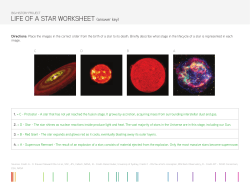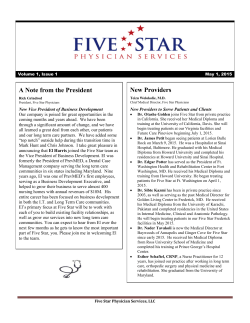
Chapter 29: Stars - Mr. Pelton Science
4/9/2015 CHAPTER 29: STARS BELL RINGER: • Where does the energy of the Sun come from? • Compare the size of the Sun to the size of Earth. 1 4/9/2015 CHAPTER 29.1: THE SUN • What are the properties of the Sun? • What are the layers of the Sun’s atmosphere? • What is solar wind and what causes sunspots? • What are solar activity cycles? • What gives the Sun all of its energy? • What is the composition of the Sun? PROPERTIES OF THE SUN • The Sun is the largest object in the solar system. • It would take 109 Earths, or about 10 Jupiters, lined up edge to edge to fit across the Sun. • The Sun contains 99% of all the mass of the solar system. 2 4/9/2015 3 4/9/2015 PROPERTIES OF THE SUN • The Sun’s density is similar to the densities of the gas giant planets. • The density in the center of the sun is 13 times the density of Lead. • A pair of dice as dense as the Sun’s center would have a mass of about 1 kg (2.2 lbs). PROPERTIES OF THE SUN • The Sun’s interior is gaseous throughout because of its high temperature. • All of the gas in the center of the sun is completely ionized (plasma). • The Sun produces the equivalent of 4 trillion 100W lightbulbs of light each second. 4 4/9/2015 THE SUN’S ATMOSPHERE THE PHOTOSPHERE • The photosphere is the visible surface of the Sun. • It is approximately 400 km thick and has an average temperature of 5800K • Most of the visible light of the Sun is emitted from the photosphere. 5 4/9/2015 THE PHOTOSPHERE THE CHROMOSPHERE • Outside the photosphere is the chromosphere. • Average Thickness: 2500km Average Temperature: 30,000 K • Visible only during a solar eclipse when the photosphere is blocked. • Special filters can be used to view this layer. (Mostly UV Rays) 6 4/9/2015 THE CHROMOSPHERE THE CORONA • The outermost layer of the Sun’s atmosphere. • Extends for several million kilometers from the outside edge of the chromosphere. • Temperature: 1 Million – 2 Million K • Radiation is mostly X rays. 7 4/9/2015 THE CORONA THE SUN’S ATMOSPHERE 8 4/9/2015 SOLAR WIND • The corona of the Sun does not have an abrupt edge. • Gas flows outward from the corona at high speeds and forms the solar wind. • These high energy particles are deflected by Earth’s magnetic field and trapped in two huge rings. (the Van Allen belts) SOLAR WIND • High energy particles in these belts collide with gases in Earth’s atmosphere, causing them to give off light. • This light is called the aurora. 9 4/9/2015 10 4/9/2015 SUNSPOTS • The Sun’s magnetic field disturbs the solar atmosphere and causes features called sunspots. • Sunspots are dark features on the surface of the photosphere. 11 4/9/2015 THE PHOTOSPHERE SUNSPOTS • Sunspots appear dark because they are cooler than the surrounding areas. • Sunspots are located where the Sun’s magnetic fields penetrate the photosphere. 12 4/9/2015 SUNSPOTS • Astronomers have observed that the number of sunspots changes regularly, reaching a maximum number ever 11.2 years. • At this point, the Suns magnetic field reverses. SOLAR FLARES • Solar flares are violent eruptions of particles and radiation from the surface of the sun. • The released particles often escape the surface of the sun and bombard earth a few days later. 13 4/9/2015 SOLAR FLARES PROMINENCE • Another active feature associated with flares is a prominence. • A prominence is an arc of gas that is ejected from the chromosphere and rains back to the surface. 14 4/9/2015 PROMINENCE THE SOLAR INTERIOR • Nuclear fusion occurs in the core of the Sun, where pressure and temperature are extremely high. • Fusion is the combination of lightweight atoms into heavier atoms. (Hydrogen into Helium) 15 4/9/2015 THE SOLAR INTERIOR THE SOLAR INTERIOR • In the core of the Sun, helium is a product of the process in which hydrogen nuclei fuse. • This produces massive amounts of energy since mass is lost during the process. E=mc2 16 4/9/2015 THE SOLAR INTERIOR • At the Sun’s rate of hydrogen fusing, it is about halfway through its lifetime, with approximately 5 billion years left. ENERGY TRANSPORT 17 4/9/2015 ENERGY TRANSPORT SPECTRA • A spectrum is visible light arranged according to wavelengths. 18 4/9/2015 SPECTRA • A spectrum from the Sun’s light shows a series of dark bands. These dark lines are caused by different chemicals that absorb light at specific wavelengths. SOLAR COMPOSITION 19 4/9/2015 BELL RINGER: • What is a constellation? • Write down the names of any constellations you know. CHAPTER 29.2: MEASURING THE STARS • How are distances between stars measured? • What is the difference between brightness and luminosity? • What are the properties used to identify stars? 20 4/9/2015 GROUPS OF STARS • Many ancient civilizations looked at the brightest stars and named groups of them after animals, mythological characters, or everyday objects. • These groups of stars are called constellations. GROUPS OF STARS • Some constellations are visible throughout the year, depending on the observer’s location. • The Big Dipper (Ursa Major) is a circumpolar constellation, meaning it can be seen year round. 21 4/9/2015 GROUPS OF STARS • Other consellations can only be seen during certain times of the year because of Earth’s changing position in its orbit. • Orion is a constellation we can only see during the winter. • The most familiar constellations are the 12 signs of the zodiac. 22 4/9/2015 23 4/9/2015 GROUPS OF STARS • Star clusters are groups of stars that are gravitationally bound to one another. • The Pleiades is an open group cluster. • M13 is a globular cluster. 24 4/9/2015 25 4/9/2015 POLARIS: THE NORTH STAR SIRIUS: THE DOG STAR 26 4/9/2015 TONIGHTS SKY: JUPITER AND THE SEVEN SISTERS GROUPS OF STARS • When only two stars are gravitationally bound together in orbit, they are called binary stars. • More than half of the stars in the sky are either binary stars or members of multiple star systems. 27 4/9/2015 28 4/9/2015 STAR CLASSIFICATION • Most stars are currently classified using the letters O, B, A, F, G, K, and M, with the O class stars being the hottest and the M class stars being the coolest. 29 4/9/2015 STAR CLASSIFICATION • Stars are then subdivided from with numbers from 0-9 within the spectral category. • Ex: O1, 05, A9, G7, M1 • The sun is a type G2 star with a surface temperature of 5800K STAR CLASSIFICATION • Temperatures range from 50,000 K for type O stars to as low as 2000 K for type M stars. 30 4/9/2015 STAR CLASSIFICATION • Useful mnemonic device for remembering the spectral type letters: "Oh Boy An F Grade Kills Me". STAR CLASSIFICATION • All stars have nearly identical compositions despite the differences in their spectra. • Typically, a star is 70% H, 25% He, and 2% other elements 31 4/9/2015 H-R DIAGRAMS • A Hertzberg-Russell diagram demonstrates how the properties of mass, luminosity, temperature, and diameter of a star are related. 32 4/9/2015 MAIN SEQUENCE STARS • Most stars occupy the region in the diagram called the main sequence, which runs diagonally from the upper left corner to the lower right corner. MAIN SEQUENCE STARS • 90% of stars, including the Sun, fall within the main sequence. • Main sequence stars are stable and fuse hydrogen in their core. 33 4/9/2015 MAIN SEQUENCE STARS • About 90 percent of stars, including the sun, fall along the main sequence. • The sun lies near the center of the sequence, being of average temperature and luminosity. 34 4/9/2015 ABSORPTION AND EMISSION LINES SPECTRA • A spectrum is visible light arranged according to wavelengths. 35 4/9/2015 SPECTRA • A spectrum from the Sun’s light shows a series of dark bands. These dark lines are caused by different chemicals that absorb light at specific wavelengths. DOPPLER SHIFT • The Doppler effect is used in astronomy to tell whether a star or other object is moving towards us or away from us, as well as the direction of rotation. • The Doppler effect also works the same way with sound. 36 4/9/2015 THE DOPPLER EFFECT • When a star moves toward the observer, the light emitted by the star shifts toward the blue end of the spectrum. • When a star moves away from the observer, the light shifts towards red. 37 4/9/2015 SELLAR POSITIONS AND DISTANCES • Astronomers use two units to measure long distances. • The light-year (ly): the distance light travels in one year (9.461x1012 km) • A parsec (pc) = 3.26 ly 38 4/9/2015 PARALLAX • Precise position measurements are important for measuring distance to stars. • Nearby stars shift in position when observed at different times in Earths orbit.. PARALLAX • This apparent shift in position caused by the motion of the observer is called parallax 39 4/9/2015 40 4/9/2015 BASIC STAR PROPERTIES • One of the most basic observable properties of a star is how bright it appears, or apparent magnitude. • The ancient Greeks established a classification system based on star brightness which we still use today. 41 4/9/2015 BASIC STAR PROPERTIES • Apparent magnitude does not indicate actual brightness of a star because it does not account for distance. • Absolute magnitude is how bright a star would appear if it were placed at a distance of 10 pc BASIC STAR PROPERTIES • Luminosity is a measurement of the energy a star puts out per unit of time. • Luminosity is measured in units of energy emitted per second. (Watts) 42 4/9/2015 STELLAR SPECTRAL LINES • Types of Spectra Continuous - No spectral lines Absorption - Dark lines superimposed on continuous spectrum Emission - Isolated bright lines STELLAR SPECTRAL LINES • Kirchoff’s Laws 1. An opaque object emits a continuous spectrum. 2. An opaque object viewed through a cooler gas will produce an absorption spectrum. 3. A gas viewed against an empty background produces an emission spectrum 43 4/9/2015 STELLAR EVOLUTION • Mass determines a star’s temperature, luminosity, and diameter. • Mass and composition alone determine almost all of a star’s properties 44 4/9/2015 STELLAR EVOLUTION • The more massive a star is, the greater the gravity pressing inward, and the hotter and more dense the star must be to balance its own gravity. • Hydrostatic equilibrium 45 4/9/2015 STAR FORMATION • All stars form in much the same way as our Sun. • The formation of a star begins with a cloud of interstellar dust and gas called a nebula. THE EAGLE NEBULA 46 4/9/2015 STAR FORMATION • As this cloud contracts by its own gravity, its rotation forces it into a disk shape with a hot, condensed object at the center, called a protostar STAR FORMATION • Once ignition temperature is reached, nuclear reactions take place and the object becomes a new star. 47 4/9/2015 PROTOSTAR PROTOSTAR 48 4/9/2015 STAR FORMATION • The first reaction to ignite once nuclear fusion begins is the conversion of hydrogen into helium H + H He LIFE CYCLE OF A STAR • It takes about 10 billion years for a star with the mass of the sun to convert all of the hydrogen in its core into helium. • From here the next step in its life cycle is to become a red giant. 49 4/9/2015 LIFE CYCLE OF A STAR • Helium is converted into carbon in the central region of a red giant. • Hydrogen still fuses into helium in a thin shell which forces the outer layers of the star to expand and cool. 50 4/9/2015 LIFE CYCLE OF A STAR • After all the helium in the core is depleted, the red giant is left with a core made of carbon. • All of the layers of gas are expelled away in a planetary nebula and a core of carbon is left behind (white dwarf) LIFE CYCLE OF A STAR • Supergiants are massive stars 8-20 times larger than our Sun. • Many elements are formed in supergiant stars by fusion reactions, the heaviest of which is Iron. 51 4/9/2015 LIFE CYCLE OF A STAR • Such massive stars are too large to be supported by electron pressure. • They come to a very violent end forming a neutron star after a supernova, or collapsing to form a black hole. 52 4/9/2015 LIFE CYCLE OF A STAR • A pulsar is a neutron star which emits intense radiation on its poles and rotates several times per second. 53 4/9/2015 54
© Copyright 2025









